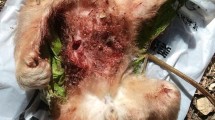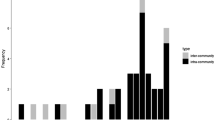Abstract
Infanticide is considered a conspicuous expression of sexual conflict amongst mammals, including at least 35 primate species. Here we describe two suspected and one attempted case of intragroup infanticide in spider monkeys that augment five prior cases of observed or suspected infanticide in this genus. Contrary to the typical pattern of infanticide seen in most primate societies, where infants are killed by conspecifics independent of their sex, all eight cases of observed or suspected infanticide in spider monkeys have been directed toward male infants within their first weeks of life. Moreover, although data are still scant, infanticides seem to be perpetrated exclusively by adult males against infants from their own social groups and are not associated with male takeovers or a sudden rise in male dominance rank. Although the slow reproductive cycles of spider monkeys might favor the presence of infanticide because of the potential to shorten females’ interbirth intervals, infanticide is nonetheless uncommon among spider monkeys, and patterns of male-directed infanticide are not yet understood. We suggest that given the potentially close genetic relationships among adult males within spider monkey groups, and the need for males to cooperate with one another in territorial interactions with other groups of related males, infanticide may be expected to occur primarily where the level of intragroup competition among males outweighs that of competition between social groups. Finally, we suggest that infanticide in spider monkeys may be more prevalent than previously thought, given that it may be difficult for observers to witness cases of infanticide or suspected infanticide that occur soon after birth in taxa that are characterized by high levels of fission–fusion dynamics. Early, undetected, male-biased infanticide could influence the composition of spider monkey groups and contribute to the female-biased adult sex ratios often reported for this genus.


Similar content being viewed by others
References
Arnqvist G, Rowe L (2005) Sexual conflict. Princeton University Press, Princeton
Aureli F, Schaffner CM (2008) Social interactions, social relationships and the social system of spider monkeys. In: Campbell CJ (ed) Spider monkeys: behavior, ecology and evolution of the genus Ateles. Cambridge University Press, Cambridge, pp 236–265
Aureli F, Schaffner CM, Verpooten J, Slater K, Ramos-Fernandez G (2006) Raiding parties of male spider monkeys: insights into human warfare? Am J Phys Anthropol 131:486–497
Aureli F, Di Fiore A, Murillo-Chacon E, Kawamura S, Schaffner CM (2013) Male philopatry in spider monkeys revisited. Am J Phys Anthropol 152:86–95
Castellanos HG, Chanin P (1996) Seasonal differences in food choice and patch preference of long-haired spider monkeys (Ateles belzebuth). In: Norconk MA, Rosenberger AL, Garber PA (eds) Adaptive Radiations of Neotropical Primates. Plenum Press, New York, pp 451–466
Campbell CJ (2000) The reproductive biology of black-handed spider monkeys (Ateles geoffroyi): integrating behavior and endocrinology (Doctoral dissertation). University of California, Berkeley
Chapman CA, Fedigan LM, Fedigan L, Chapman LJ (1989) Post-weaning resource competition and sex ratios in spider monkeys. Oikos. pp : 315–319
Dew JL (2001) Synecology and seed dispersal in woolly monkeys (Lagothrix lagotricha poeppigii) and spider monkeys (Ateles belzebuth belzebuth) in Parque Nacional Yasuní, Ecuador (Doctoral dissertation). University of California, Davis
Di Fiore A, Link A (2011) Male mating strategies and paternity in white bellied spider monkeys (Ateles belzebuth) of Amazonian Ecuador. Am J Primatol 73:72
Di Fiore A, Link A, Schmitt CA, Spehar SN (2009) Dispersal patterns in sympatric woolly and spider monkeys: integrating molecular and observational data. Behaviour 146:437–470
Di Fiore A, Link A, Campbell CJ (2011) The atelines: behavioral and socioecological diversity in a New World radiation. Primates in perspective, 2nd edition. Oxford, Oxford University Press, p 155–188
Fedigan LM, Baxter MJ (1984) Sex differences and social organization in free-ranging spider monkeys (Ateles geoffroyi). Primates 25:279–294
Gibson KN (2010) Male mating tactics in spider monkeys: sneaking to compete. Am J Primatol 72:794–804
Gibson KN, Vick LG, Palma AC, Carrasco FM, Taub D, Ramos-Fernández G (2008) Intra-community infanticide and forced copulation in spider monkeys: a multi-site comparison between Cocha Cashu, Peru and Punta Laguna, Mexico. Am J Primatol 70:485–489
Hamilton WD (1964) The genetical evolution of social behaviour. I. J Theoretical Biol 7:1–16
Hartwell KS, Notman H, Bonenfant C, Pavelka MS (2014) Assessing the occurrence of sexual segregation in spider monkeys (Ateles geoffroyi yucatanensis), its mechanisms and function. Int J Primatol 35:425–444
Hiraiwa-Hasegawa M (1987) Infanticide in primates and a possible case of male-biased infanticide in chimpanzees. In: Brown Y, Kikkawa JL (eds) Animal societies: theories and facts. Japan Science Society Press, Tokyo, pp 125–139
Hrdy SB (1979) Infanticide among animals: a review, classification, and examination of the implications for the reproductive strategies of females. Ethol Sociobiol 1:13–40
Klein LL (1972) The ecology and social organization of the spider monkey, Ateles belzebuth (Doctoral dissertation). University of California, Berkeley
Klein LL (1974) Agonistic behavior in Neotropical primates. Academic Press, New York
Link A (2011) Social and ecological determinants of “fission fusion” sociality and grouping strategies in the white bellied spider monkey (Ateles belzebuth belzebuth) in a lowland rainforest in Western Amazonia (Doctoral dissertation). New York University, New York
Link A, Fiore A (2013) Effects of predation risk on the grouping patterns of white-bellied spider monkeys (Ateles belzebuth belzebuth) in Western Amazonia. Am J Phys Anthropol 150:579–590
Link A, De Luna AG, Alfonso F, Giraldo-Beltran P, Ramirez F (2010) Initial effects of fragmentation on the density of three Neotropical primate species in two lowland forests of Colombia. Endanger Species Res 13:41–50
Link A, Galvis N, Fleming E, Di Fiore A (2011) Patterns of mineral lick visitation by spider monkeys and howler monkeys in Amazonia: are licks perceived as risky areas? Am J Primatol 73:386–396
Link A, Galvis N, Marquez M, Guerrero J, Solano C, Stevenson PR (2012) Diet of the critically endangered brown spider monkey (Ateles hybridus) in an inter-Andean lowland rainforest in Colombia. Am J Primatol 74:1097–1105
Nunes A, Chapman CA (1997) A re-evaluation of factors influencing the sex ratio of spider monkeys populations with new data from Maraca Isaland, Brazil. Folia Primatol 68:31–33
Palombit RA (2000) Male–female social relationships and infanticide in animals. In: van Schaik CP, Janson CH (eds) Male infanticide and its implications. Cambridge University Press, Cambridge, pp 239–268
Palombit RA (2009) Friendships with males: a female counterstrategy to infanticide in the Okavango chacma baboons. In: Muller MN, Wrangham RW (eds) Male aggression against females in primates. Harvard University Press, Cambridge MA
Palombit RA (2012) Infanticide: male strategies and female counterstrategies. The evolution of primate societies. The University of Chicago Press, London, pp 432–468
Ramos-Fernandez G, Vick L, Aureli F, Schaffner CM, Taub DM (2003) Behavior ecology and conservation status of spider monkeys in the Otoch Maáx Yetel Kooh protected area. Neotropical Primates 11:155–158
Ramos-Fernández G, Pinacho-Guendulain B, Miranda-Pérez A, Boyer D (2011) No evidence of coordination between different subgroups in the fission–fusion society of spider monkeys (Ateles geoffroyi). Int J Primatol 32:1367–1382
Rimbach R, Pardo-Martinez A, Montes-Rojas A, Di Fiore A, Link A (2012) Interspecific infanticide and infant-directed aggression by spider monkeys (Ateles hybridus) in a fragmented forest in Colombia. Am J Primatol 74:990–997
Shimooka Y (2003) Seasonal variation in association patterns of wild spider monkeys (Ateles belzebuth belzebuth) at La Macarena, Colombia. Primates 44:83–90
Shimooka Y, Campbell CJ, Di Fiore A, Felton AM, Izawa K, Link A, Nishimura A, Ramos-Fernández G, Wallace R (2008) Demography and group composition of Ateles. In: Campbell CJ (ed) Spider monkeys: behavior, ecology and evolution of the genus Ateles. Cambridge University Press, Cambridge, pp 329–348
Sterck EH, Watts DP, van Schaik CP (1997) The evolution of female social relationships in nonhuman primates. Behav Ecol Sociobiol 41:291–309
Symington MM (1987a) Sex ratio and maternal rank in wild spider monkeys: when daughters disperse. Behav Ecol Sociobiol 20:421–425
Symington MM (1987b) Ecological and social correlates of party size in the black spider monkey, Ateles paniscus chamek (Doctoral dissertation). Princeton University, New Jersey
Symington MM (1990) Fission-fusion social organization in Ateles and Pan. Int J Primatol 11:47–61
Trivers R (1972) Parental investment and sexual selection. In: Campbell B (ed) Sexual selection and the descent of man, 1871–1971. Aldine, New York, pp 136–179
Valero A, Schaffner CM, Vick LG, Aureli F, Ramos-Fernandez G (2006) Intragroup lethal aggression in wild spider monkeys. Am J Primatol 68:732–737
van Roosmalen MGM (1985) Habitat preferences, diet, feeding strategy and social organization of the black spider monkeys (Ateles paniscus paniscus) Linnaeus 1758 in Surinam. Acta Amaz 15:1–238
van Schaik CP (2000) Infanticide by male primates: the sexual selection hypothesis revisited. In: van Schaik CP, Janson CH (eds) Infanticide by males and its implications. Cambridge University Press, Cambridge, pp 27–61
van Schaik CP, Janson CH (2000) Infanticide by males and its implications. Cambridge University Press, Cambridge
van Schaik CP, Kappeler PM (1997) Infanticide risk and the evolution of male–female association in primates. Proceedings of the Royal Society of London. Series B, Biol Sci 264: 1687–1694
Vick LG (2008) Immaturity in spider monkeys: a risky business. In: Campbell CJ (ed) Spider monkeys: behavior, ecology and evolution of the genus Ateles. Cambridge University Press, Cambridge, pp 288–328
Wilson ML, Boesch C, Fruth B, Furuichi T, Gilby IC, Hashimoto C, Hobaiter CL, Hofmann G, Itoh N, Koops K, Lloyd JN, Matsuzawa T, Mitani JC, Mjungu DC, Morgan D, Muller MN, Mundry R, Nakamura M, Pruetz J, Pusey AE, Riedel J, Sanz C, Schel AM, Simmons N, Waller M, Watts DP, White F, Wittig R, Zuberbühler K, Wrangham RW (2014) Lethal aggression in Pan is better explained by adaptive strategies than human impacts. Nature 513:414–417
Acknowledgments
The authors are very grateful to the Ecuadorian, Colombian, and Belizean governments and their Ministerios de Ambiente for permission to work at the Tiputini Biodiversity Station, San Juan de Carare, and Runaway Creek Nature Reserve sites, respectively. The authors also thank (1) the Universidad San Francisco de Quito and the dedicated TBS field staff who have provided invaluable scientific and logistical support in Ecuador, (2) the Lalinde and de Greiff families who have allowed us to work at SJ for the past 6 years, and (3) Dr. Gil and Lilian Boese from the Zoological Society of Milwaukee, the Foundation for Wildlife Conservation for permission to work at RCNR, and Birds Without Borders/Aves Sin Fronteras and the Belize Zoo and Tropical Education Center for ongoing support. The authors also especially thank Ana Palma, Laura Abondano, Liz Diaz, and Norma Lopez for valuable help in the field, and John Mitani and two anonymous reviewers for comments on an earlier version of this manuscript. This research was supported, in part, by the National Science Foundation of the United States of America (Grant BCS1062540), the National Geographic Society (CRE Grant 8785-10), Becas de Diversidad de Ecopetrol, the Mohamed bin Zayed Species Conservation Fund, the Natural Sciences and Engineering Research Council of Canada, New York University, and the University of Calgary.
Ethical statement
This research complied with protocols approved by the Institutional Animal Care Committee of the University of Texas at Austin, adhered to the legal requirements of Ecuador, Colombia, and Belize and adhered to the Primate Society of Japan's Principles for the Ethical Treatment of Non-Human Primates.
Author information
Authors and Affiliations
Corresponding author
About this article
Cite this article
Alvarez, S., Di Fiore, A., Champion, J. et al. Male-directed infanticide in spider monkeys (Ateles spp.). Primates 56, 173–181 (2015). https://doi.org/10.1007/s10329-014-0454-y
Received:
Accepted:
Published:
Issue Date:
DOI: https://doi.org/10.1007/s10329-014-0454-y




